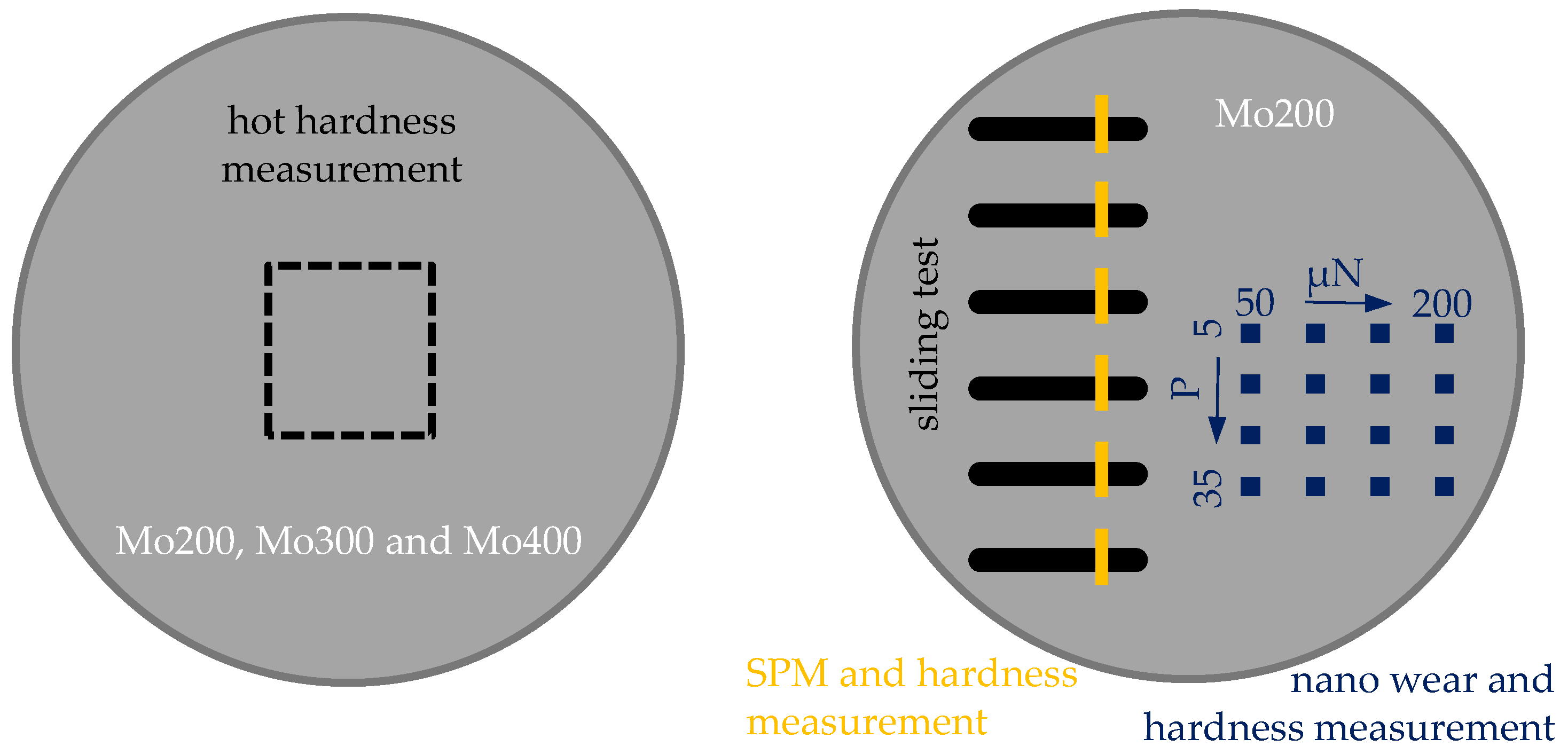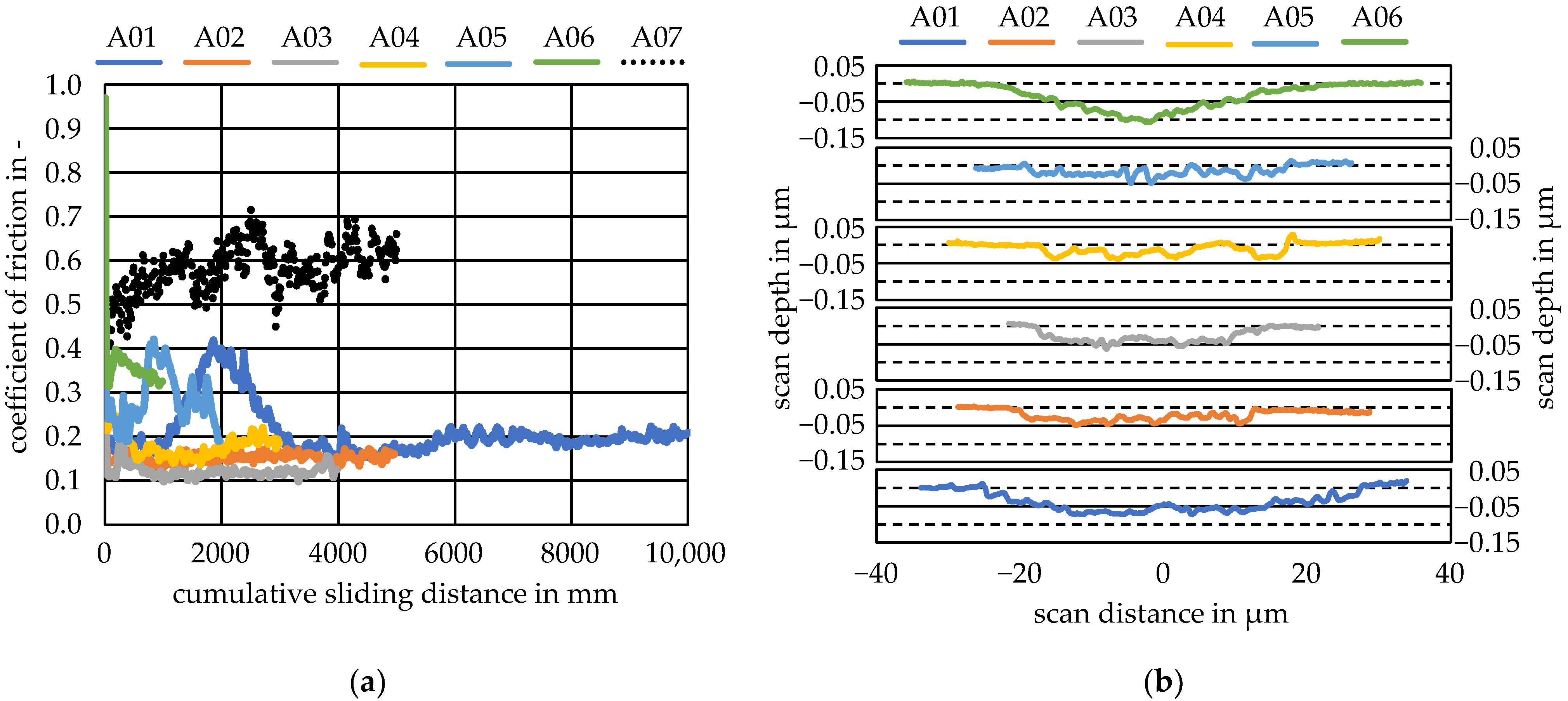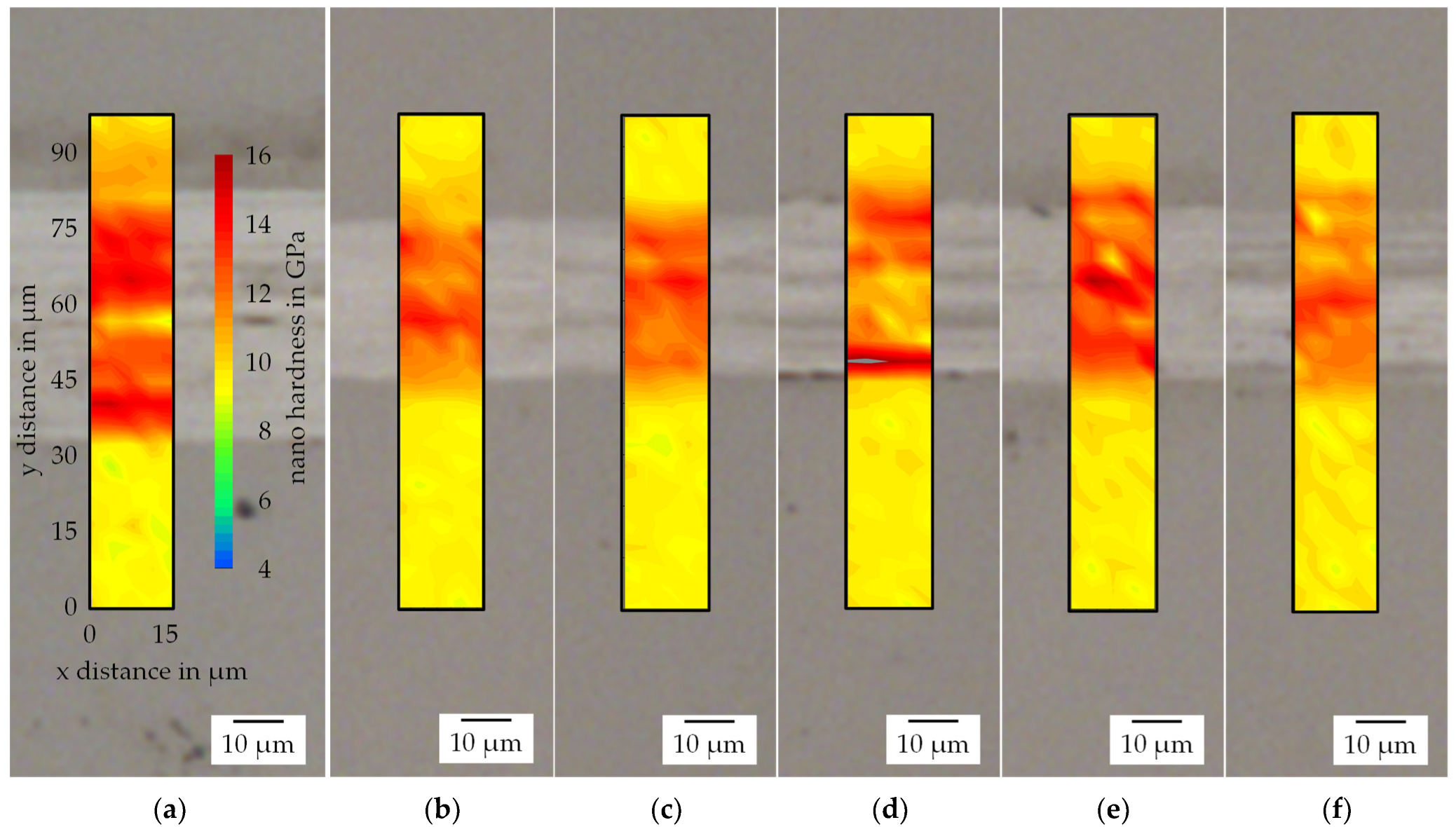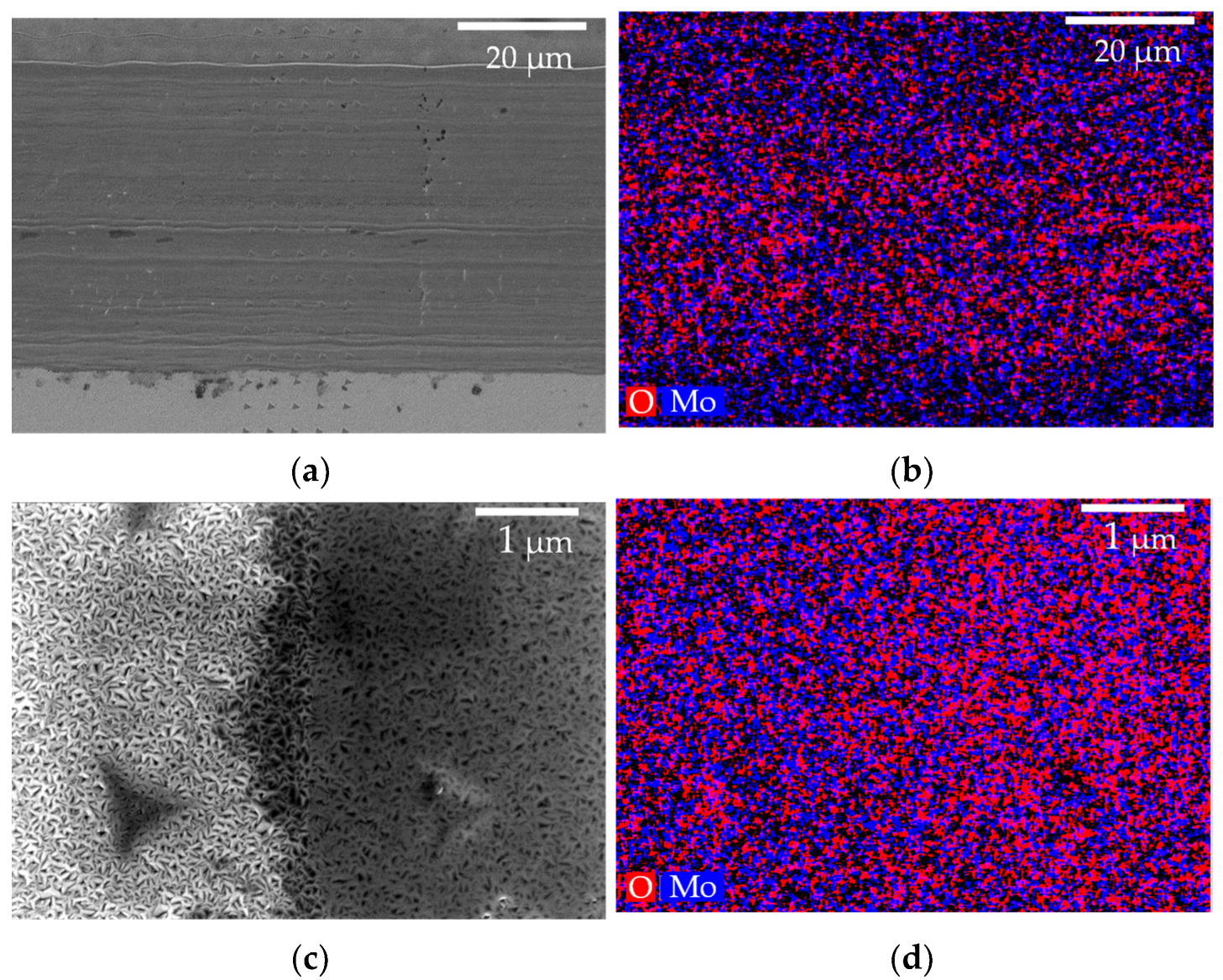Investigation of the Hardness Development of Molybdenum Coatings under Thermal and Tribological Loading
Abstract
:1. Introduction
- How does the sputtering temperature affect the hot hardness of the Mo coating?
- Why is pure molybdenum so wear-resistant and what mechanisms are responsible for this?
- Are the wear mechanisms different at the nano and micro level and how can this be used for the wear modelling of molybdenum coatings?
2. Materials and Methods
2.1. Manufacture of the Specimens
2.2. Tribological Investigation
2.3. Nanotechnical Investigations
2.4. SEM and Optical Investigations
3. Results and Discussions
3.1. Nanotechnical Investigations
3.2. Sliding Tests
3.3. Wear Track Analysis
4. Conclusions
Author Contributions
Funding
Data Availability Statement
Acknowledgments
Conflicts of Interest
References
- Vazirisereshk, M.R.; Martini, A.; Strubbe, D.A.; Baykara, M.Z. Solid Lubrication with MoS2: A Review. Lubricants 2019, 7, 57. [Google Scholar] [CrossRef] [Green Version]
- Gokce, B.; Geren, N.; Izciler, M. Effect of substrate surface roughness on the wear of molybdenum disulphate coated rolling contact bearings. Mater. Test. 2021, 63, 848–854. [Google Scholar] [CrossRef]
- Yilmaz, M.; Kratzer, D.; Lohner, T.; Michaelis, K.; Stahl, K. A study on highly-loaded contacts under dry lubrication for gear applications. Tribol. Int. 2018, 128, 410–420. [Google Scholar] [CrossRef]
- Yaqub, T.B.; Hebbar Kannur, K.; Vuchkov, T.; Pupier, C.; Héau, C.; Cavaleiro, A. Molybdenum diselenide coatings as universal dry lubricants for terrestrial and aerospace applications. Mater. Lett. 2020, 275, 128035. [Google Scholar] [CrossRef]
- Ragupathy, K.; Velmurugan, C.; Ebenezer Jacob Dhas, D.S.; Senthilkumar, N.; Leo Dev Wins, K. Prediction of Dry Sliding Wear Response of AlMg1SiCu/Silicon Carbide/Molybdenum Disulphide Hybrid Composites Using Adaptive Neuro-Fuzzy Inference System (ANFIS) and Response Surface Methodology (RSM). Arab. J. Sci. Eng. 2021, 46, 12045–12063. [Google Scholar] [CrossRef]
- Subitha, M.; Sasikanth, S.M.; Bindhu, B. Ionic liquid assisted exfoliation and dispersion of molybdenum disulphide: Synthesis and characterization. In Proceedings of the Prof. Dinesh Varshney Memorial National Conference on Physics and Chemistry of Materials: NCPCM 2018, Indore, India, 27–28 December 2018; p. 20098. [Google Scholar]
- Kumar, V.P.; Panda, D.K. Review—Next Generation 2D Material Molybdenum Disulfide (MoS2): Properties, Applications and Challenges. ECS J. Solid State Sci. Technol. 2022, 11, 33012. [Google Scholar] [CrossRef]
- Idir, A.; Younes, R.; Mouadji, Y. Study of wear resistance in dry and lubricated regime of molybdenum coating obtained by thermal spraying. J. New Technol. Mater. 2019, 8, 97–101. [Google Scholar]
- Schöler, S.; Schmieding, M.; Heimes, N.; Pape, F.; Behrens, B.-A.; Poll, G.; Möhwald, K. Characterization of Molybdenum Based Coatings on 100Cr6 Bearing Steel Surfaces. Tribol. Online 2020, 15, 181–185. [Google Scholar] [CrossRef]
- Schöler, S.; Heimes, N.; Konopka, D.; Behrens, B.A.; Poll, G.; Möhwald, K. Molybdenum Based Coatings on 100Cr6 Bearing Steel Surfaces. 4. 2021, pp. 25–26. Available online: https://www.pzh.uni-hannover.de/fileadmin/pzh-ifum/Dasifum/Manuskript_Schoeler_CZM_2021.pdf (accessed on 27 June 2023).
- Behrens, B.-A.; Poll, G.; Möhwald, K.; Schöler, S.; Pape, F.; Konopka, D.; Brunotte, K.; Wester, H.; Richter, S.; Heimes, N. Characterization and Modeling of Nano Wear for Molybdenum-Based Lubrication Layer Systems. Nanomaterials 2021, 11, 1363. [Google Scholar] [CrossRef]
- Deambrosis, S.M.; Miorin, E.; Montagner, F.; Zin, V.; Fabrizio, M.; Sebastiani, M.; Massimi, F.; Bemporad, E. Structural, morphological and mechanical characterization of Mo sputtered coatings. Surf. Coat. Technol. 2015, 266, 14–21. [Google Scholar] [CrossRef]
- Bolef, D.I.; de Klerk, J. Elastic Constants of Single-Crystal Mo and W between 77° and 500° K. J. Appl. Phys. 1962, 33, 2311–2314. [Google Scholar] [CrossRef]
- Farraro, R.; Mclellan, R.B. Temperature dependence of the Young’s modulus and shear modulus of pure nickel, platinum, and molybdenum. Met. Trans. A 1977, 8, 1563–1565. [Google Scholar] [CrossRef]
- Pisarenko, G.S.; Borisenko, V.A.; Kashtalyan, Y.A. The effect of temperature on the hardness and modulus of elasticity of tungsten and molybdenum (20–2700‡). Powder Met. Met. Ceram. 1964, 1, 371–374. [Google Scholar] [CrossRef]
- Minnert, C.; Oliver, W.C.; Durst, K. New ultra-high temperature nanoindentation system for operating at up to 1100 °C. Mater. Des. 2020, 192, 108727. [Google Scholar] [CrossRef]
- Heimes, N.; Pape, F.; Poll, G.; Konopka, D.; Schöler, S.; Möhwald, K.; Behrens, B.-A. Characterisation of Self-Regenerative Dry Lubricated Layers on Mo-Basis by Nano Mechanical Testing. In Production at the Leading Edge of Technology; Wulfsberg, J.P., Hintze, W., Behrens, B.-A., Eds.; Springer: Berlin/Heidelberg, Germany, 2019; pp. 139–148. ISBN 978-3-662-60416-8. [Google Scholar]
- Walia, S.; Nili, H.; Balendhran, S.; Late, D.J.; Sriram, S.; Bhaskaran, M. In situ characterisation of nanoscale electromechanical properties of quasi-two-dimensional MoS2 and MoO3. arXiv 2014, arXiv:1409.4949. [Google Scholar]
- Konopka, D.; Pape, F.; Heimes, N.; Matthias, T.; Schöler, S.; Möhwald, K.; Behrens, B.-A.; Poll, G. Micro- and nanotribological characterization of molybdenum oxide based coatings on 100Cr6 bearing steel surfaces. In Proceedings of the BALTTRIB 2019: X International Scientific Conference, Vytautas Magnus University, Agriculture Academy, Kaunas, Lithuania, 14–16 November 2019; pp. 308–315. [Google Scholar] [CrossRef]
- Konopka, D.; Pape, F.; Heimes, N.; Behrens, B.-A.; Möhwald, K.; Poll, G. Functionality Investigations of Dry-Lubricated Molybdenum Trioxide Cylindrical Roller Thrust Bearings. Coatings 2022, 12, 591. [Google Scholar] [CrossRef]
- Oliver, W.C.; Pharr, G.M. An improved technique for determining hardness and elastic modulus using load and displacement sensing indentation experiments. J. Mater. Res. 1992, 7, 1564–1583. [Google Scholar] [CrossRef]
- Fischer-Cripps, A.C.; Nicholson, D.W. Nanoindentation. Mechanical Engineering Series. Appl. Mech. Rev. 2004, 57, B12. [Google Scholar] [CrossRef]
- Behrens, B.-A.; Bouguecha, A.; Vucetic, M.; Peshekhodov, I.; Matthias, T.; Kolbasnikov, N.; Sokolov, S.; Ganin, S. Experimental investigations on the state of the friction-welded joint zone in steel hybrid components after process-relevant thermo-mechanical loadings. In Proceedings of the ESAFORM 2016: 19th International ESAFORM Conference on Material Forming, Nantes, France, 27–29 April 2016; p. 130013. [Google Scholar]
- Heimes, N.; Pape, F.; Konopka, D.; Schöler, S.; Möhwald, K.; Poll, G.; Behrens, B.-A. Investigation of the Scaling of Friction Coefficients from the Nano to the Micro Level for Base Materials and Coatings. In Production at the Leading Edge of Technology; Behrens, B.-A., Brosius, A., Hintze, W., Ihlenfeldt, S., Wulfsberg, J.P., Eds.; Springer: Berlin/Heidelberg, Germany, 2021; pp. 161–170. ISBN 978-3-662-62137-0. [Google Scholar]
- Luft, A. The correlation between dislocation structure and work-hardening behaviour of molybdenum single crystals deformed at 293° K. Phys. Stat. Sol. B 1970, 42, 429–440. [Google Scholar] [CrossRef]
- Kim, J.-Y.; Jang, D.; Greer, J.R. Tensile and compressive behavior of tungsten, molybdenum, tantalum and niobium at the nanoscale. Acta Mater. 2010, 58, 2355–2363. [Google Scholar] [CrossRef]
- Kim, J.-Y.; Greer, J.R. Size-dependent mechanical properties of molybdenum nanopillars. Appl. Phys. Lett. 2008, 93, 101916. [Google Scholar] [CrossRef] [Green Version]
- Seynstahl, A.; Krauß, S.; Bitzek, E.; Meyer, B.; Merle, B.; Tremmel, S. Microstructure, Mechanical Properties and Tribological Behavior of Magnetron-Sputtered MoS2 Solid Lubricant Coatings Deposited under Industrial Conditions. Coatings 2021, 11, 455. [Google Scholar] [CrossRef]









| Specimen Name | Substrate Temperature in °C | Sputter Time in min | Power Density in W/cm2 | Coating Thickness in µm |
|---|---|---|---|---|
| Mo200 | 200 | 60 | 1.17 | 2.0 |
| Mo300 | 300 | |||
| Mo400 | 400 |
| Test Number | A01 | A02 | A03 | A04 | A05 | A06 | S01 |
|---|---|---|---|---|---|---|---|
| Sliding distance in mm | 10,000 | 5000 | 4000 | 3000 | 2000 | 1000 | 5000 |
Disclaimer/Publisher’s Note: The statements, opinions and data contained in all publications are solely those of the individual author(s) and contributor(s) and not of MDPI and/or the editor(s). MDPI and/or the editor(s) disclaim responsibility for any injury to people or property resulting from any ideas, methods, instructions or products referred to in the content. |
© 2023 by the authors. Licensee MDPI, Basel, Switzerland. This article is an open access article distributed under the terms and conditions of the Creative Commons Attribution (CC BY) license (https://creativecommons.org/licenses/by/4.0/).
Share and Cite
Behrens, B.-A.; Stockburger, E.; Wester, H.; Poll, G.; Pape, F.; Konopka, D.; Heimes, N. Investigation of the Hardness Development of Molybdenum Coatings under Thermal and Tribological Loading. Lubricants 2023, 11, 283. https://doi.org/10.3390/lubricants11070283
Behrens B-A, Stockburger E, Wester H, Poll G, Pape F, Konopka D, Heimes N. Investigation of the Hardness Development of Molybdenum Coatings under Thermal and Tribological Loading. Lubricants. 2023; 11(7):283. https://doi.org/10.3390/lubricants11070283
Chicago/Turabian StyleBehrens, Bernd-Arno, Eugen Stockburger, Hendrik Wester, Gerhard Poll, Florian Pape, Dennis Konopka, and Norman Heimes. 2023. "Investigation of the Hardness Development of Molybdenum Coatings under Thermal and Tribological Loading" Lubricants 11, no. 7: 283. https://doi.org/10.3390/lubricants11070283






